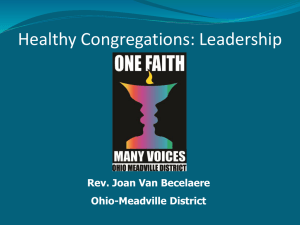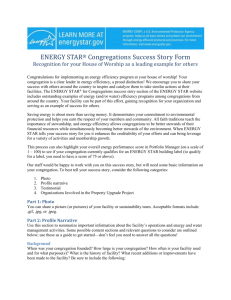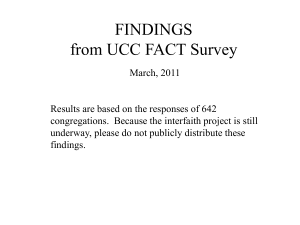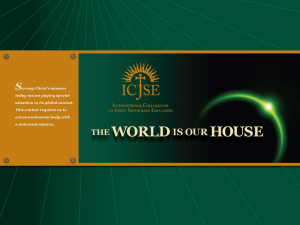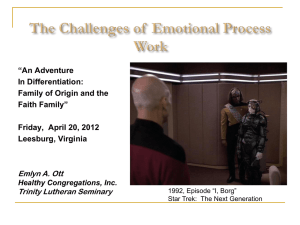Church Revision Submission 2013 DOCX / 32.1 KB
advertisement
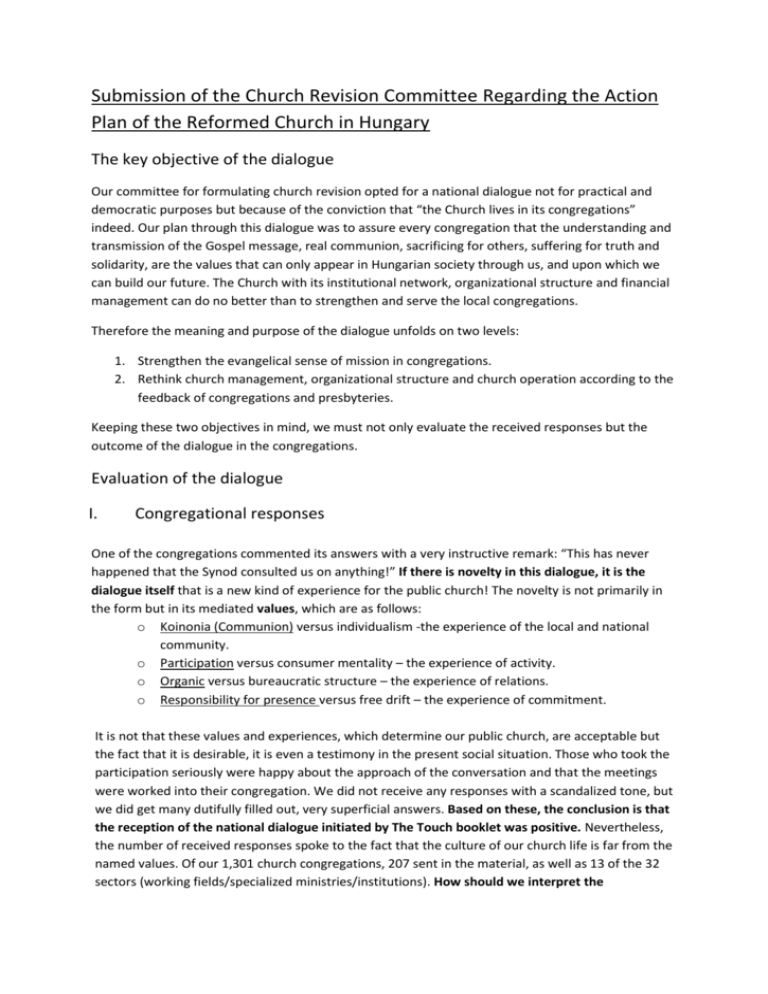
Submission of the Church Revision Committee Regarding the Action Plan of the Reformed Church in Hungary The key objective of the dialogue Our committee for formulating church revision opted for a national dialogue not for practical and democratic purposes but because of the conviction that “the Church lives in its congregations” indeed. Our plan through this dialogue was to assure every congregation that the understanding and transmission of the Gospel message, real communion, sacrificing for others, suffering for truth and solidarity, are the values that can only appear in Hungarian society through us, and upon which we can build our future. The Church with its institutional network, organizational structure and financial management can do no better than to strengthen and serve the local congregations. Therefore the meaning and purpose of the dialogue unfolds on two levels: 1. Strengthen the evangelical sense of mission in congregations. 2. Rethink church management, organizational structure and church operation according to the feedback of congregations and presbyteries. Keeping these two objectives in mind, we must not only evaluate the received responses but the outcome of the dialogue in the congregations. Evaluation of the dialogue I. Congregational responses One of the congregations commented its answers with a very instructive remark: “This has never happened that the Synod consulted us on anything!” If there is novelty in this dialogue, it is the dialogue itself that is a new kind of experience for the public church! The novelty is not primarily in the form but in its mediated values, which are as follows: o Koinonia (Communion) versus individualism -the experience of the local and national community. o Participation versus consumer mentality – the experience of activity. o Organic versus bureaucratic structure – the experience of relations. o Responsibility for presence versus free drift – the experience of commitment. It is not that these values and experiences, which determine our public church, are acceptable but the fact that it is desirable, it is even a testimony in the present social situation. Those who took the participation seriously were happy about the approach of the conversation and that the meetings were worked into their congregation. We did not receive any responses with a scandalized tone, but we did get many dutifully filled out, very superficial answers. Based on these, the conclusion is that the reception of the national dialogue initiated by The Touch booklet was positive. Nevertheless, the number of received responses spoke to the fact that the culture of our church life is far from the named values. Of our 1,301 church congregations, 207 sent in the material, as well as 13 of the 32 sectors (working fields/specialized ministries/institutions). How should we interpret the phenomenon that in the nationwide dialogue approved by the Synod only 15.91% of our congregations felt compelled to answer? (Percentage of the responding congregations - in presbytery statistics - can be found in the Annex.) a. Lack of church discipline: Namely, can everyone in the Reformed Church do whatever they want to do (without consequences)? b. Or rather, as proven by hierarchical functioning of the Reformed Church, will everyone only carry out an action if someone else from above forces them? And because of this, the committee had a good reason to avoid using power – so, is this why the pastors and congregations felt unaddressed? c. Of course it is also possible that our congregations already considered it hopeless to formulate an opinion - that anything can change in our church - therefore it was not written down. However more congregations asked, in fear of retaliation for their opinions (!), if their responses will be treated anonymously. This question cannot be decided on the basis of listening, but alarmingly, it is certain that the phenomenon itself indicates a dark spot connected to the embodied values of our church life! Our Synod will not escape an honest confrontation if it considers the future of the Church responsibly. d. Possibly the problem was with the released material, with its novelty or even its strange approach. Although we did receive feedback that the language of The Touch booklet is too complex, the number of responding congregations and their diversity clearly indicates that where they could not solve this task, the problem was not with the booklet or its interpretation, but rather the skills that the process is based upon: o common discussion within the congregation, o ability for dialogue with strangers to the church, o the wording of church’s mission, o knowledge of the Bible, o readiness for change. Is it an exaggerated expectation from a Reformed congregation to have these skills? If this is so, then it means a devastating critique of pastoral ministry and church practice. There is only one good and acceptable answer that can be given. The good answer is honest confession, repentance and renewal. The other option is to stand up and give our position to more suitable people. It is still acceptable. There are no other answers. II. Evaluation of the received responses We asked four questions and feedback: 1. Where do congregations see their own mission? 2. How do they evaluate the public Church in terms of their mission? 3. How they evaluate the service of their related institutions? 4. What are the topics where they would like to see change? According to the analysis of the received responses it is clear that there are three main topics in which radical changes are needed. These are: 1. The congregational sense of mission 2. The structure and function of the Church 3. The role of congregation-related institutions In the following, the problem of certain topics is formulated in short item sentences that are followed by a list of tasks that are needed for discovering and responding to underlying questions. 1. Lack of missionary approach 1.a. Some of our congregations just exist in the lack of a missional sense. 1.b. In this changed world our congregations are typically not able to interpret themselves in the missionary calling received from Christ. Many congregations feel lost and lonely, no vision and plan for the future, only hope for survival. 1.c. In the same way, the public Church - on its different levels – has drifted into the social role of an institution-supporting church. Tasks by subject: (Testimony in word and deed) 1. Renewal of preaching and teaching (including personal catechisms). 2. Finding and developing new and modern forms of evangelism. 3. Developing the theology of testimony, its culture and practical training. 4. In ongoing liturgical reformation, validating the missionary points of view (considering the social background of the addressed, for instance Roma, youth, homeless). 5. Application of new ICTs (Information Communications Technology) to reach the society. 6. Showing and strengthening missionary role and the possibility for diaconia as God’s love (by training, best practices, motivation). 7. Mission oriented rethinking of congregational practices, developing curriculum from “cradle to the grave” (baptism, religious education, confirmation, children and youth work, adult catechism, bible school). 8. Along these lines, expanding the instruments (good examples, thematic materials) for helping the missionary work of congregations and making it accessible. (The missionary presence of the Reformed Church in Hungary) 9. Participation in world mission: ecumenical alliance representing the Christian doctrine and point of view, international exchange of experiences. 10. The social missions, especially the development of a Roma mission strategy and its practical implementation. 11. In light of the aforementioned redefinition of mission laws, developing a mission strategy that manages congregational and social ministries in a unified system. (Consequences of pastor centrality) 12. List threats and opportunities of the pastor’s central role. Based on these, renew the pastor’s practical and mission trainings (learning new skills, introduction of every congregational model, mentoring, spiritual care and supervision of pastors, sabbatical). To accomplish this, launch the National Pastoral Institution. 13. Rethinking and reorganizing the system of mission oriented lay worker and elder trainings. 2. STRUCTURES OF TRUST AND SOLIDARITY - operation and church organization 2.a. The Synod and the four Districts cannot cooperate as “parts of one body.” Trust and solidarity is missing, which scarred the Church as a whole. 2.b. Decisions often occur along interests and not values, rivalry makes the dialogue impossible. 2.c. The unprocessed past and the lack of repentance casts a shadow on our church life. 2.d. Our corporate decisions are often not taken seriously, our decrees are not always observed. 2.e. Nevertheless our church bodies have no authority. Tasks by subject: (Congregation) 14. The parochial system can restrict the foundation of new congregations and question the sustainability of small congregations – the legal consequence being the differentiation of financial compensation and status. 15. Comprehensive evaluation of issues affecting pastoral livelihood (managing human resources). 16. Clarification of theological and legal questions for church membership. (Hierarchical structure) 17. Confirmation of decision-making based on real and public dialogue. Breakdown the old, authoritarian church governmental system, reduce the systematic hierarchy. 18. Development of a unified, transparent and useful administration instead of the selfserving bureaucracy: setting up a unified accounting and visitation (congregational auditing) system. 19. Church and academic discipline, the accountability of church leadership and hierarchical bodies (responsibility and removal of pastors). Equal enforcement of pastoral and nonpastoral officials’ responsibility, accountability on all levels. (Publicity) 20. Formulation of a more unified religious “public” doctrine: Development of internal church dialogue and culture of the debate. 21. Developing a unified communications strategy, publicity for authenticity. 3. Traps of financing an institution 3.a. The principle of an institution as the congregation’s “outstretched arm” generally does not apply. 3.b. The assumption of public duties puts the congregation’s actual mission at risk and replaces it. Also we are facing similar problems with church-run institutions. 3.c. Instead of institutions closely related to the mission of the congregation, so-called “living institutions” are forming. Meanwhile the operation of institutions will take the congregation’s resources for community building so the congregation will become dependent instead of empowered. 3.d. The poorly functioning institutions discredit the service of the church and detract the resources of the public church for mission as well. Tasks by subject: (Congregational institutions) 22. Forming the mission commitment of institutions in a unified concept. Development of religious and training plans for institution employees. 23. Developing principles of institutions and sustainable co-operation. Connection between institutions, local assigned congregations and beneficiaries’ congregations, development of co-operation principles. 24. Strengthen the communication and experience exchange of institutions. 25. Collection and evaluation of successful and failed practices over the past 20 years. 26. The development of guidelines for the intake of institutions’ employees and beneficiaries as well as remaining in contact with their relatives. (Church financing) 27. Value-based contact with the state. 28. Developing an alternative concept of church financing. Continuation of the dialogue, action plan 1. After the dialogue with the congregations, sectors and institutions, the Church Revision Committee – as its next step – calls the Synod Presidency Council for consultation. The highlighted topic – taking the upcoming elections in consideration – will be the submission’s second point; “lack of trust and solidarity” the discussion of the most important tasks related to the operation and organization of the Church. 2. At the same time, the Church Revision Committee initiates professional consultations on raised issues involving experts and stakeholders (modeled on Mission Day). From these targeted professional consultations, the Church Revision Committee expects to formulate concrete proposals for the Reformed Church in Hungary and the development of its vision. Proposal for a decision The Synod adopts the report and action plan presented by the Church Revision Committee.

